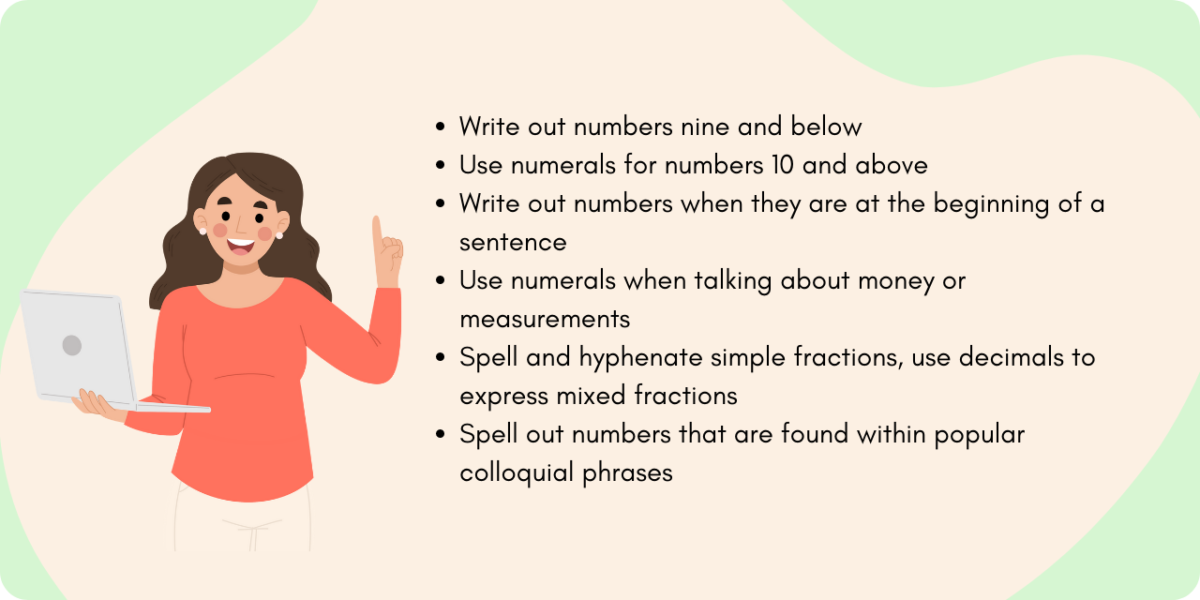If you aren’t sure about when you should spell out numbers, you’re not alone! This topic can be confusing to many writers. Let’s break down some common number rules into a simple guide that you can use to structure your writing!
When Should You Spell Out Numbers?
When it comes to spelling out numbers versus using numerals, there is no clear consensus on what is right or wrong. Depending on what you’re writing, you may be following one of these common editorial style and usage guides:
- The Chicago Manual of Style: often used in the publishing industry (such as books, non-news magazines)
- The AP Style (Associated Press Stylebook): typically used in news-related contexts
- The APA Style (American Psychological Association): often used in research writing and scientific writing
- The MLA Style (Modern Language Association): widely used and taught in high school and college academic settings
While there are differences and exceptions among these editorial style rules, we discuss some generally accepted norms for writing out numbers below.
Number Size
Spell out numbers nine and below and use numerals for numbers that are 10 and above. This is because large numbers can be cumbersome and confusing to write!
- I have 10 dollars in my wallet.
- There are four books on the shelf.
- She baked 25 cupcakes for her daughter’s birthday party.
Beginning of a Sentence
Although it’s not usually recommended to start your sentences with a number, it is almost always advised to spell out a number if it is at the beginning of a sentence.
- Ten years ago, I traveled to South America with my best friend.
- Five days is the minimum recommend stay for a trip to Tokyo.
Money, Measurements, and More
Most style guides recommend using numerals if you are writing about money, measurements, ratios, and statistics. These numbers should be accompanied by a unit of measurement, such as a dollar sign.
- My new headphones cost $150.75.
- The pencil is 15 cm in length.
- The ratio of male to female in the group fitness class was 1:2.
- She can run 20 km without stopping for a break.
- The doctor recommended a 5 mg dose of melatonin.
Fractions and Decimals
Many style guides have distinct rules for fractions. Generally, common fractions (simple fractions) should be written out and hyphenated:
- Two-thirds
- One-fourth
- Three-fifths
Mixed fractions are commonly expressed as decimals to avoid confusion:
- 7.5 (instead of “seven and one-half” or “7 1/2”)
- 10.75 (instead of “ten and three-fourths” or “10 3/4”)
- 3.25 (instead of “three and one-fourth” or “3 1/4”)
Some example sentences using decimals:
- I lived in New York City for 8.5 years.
- The company sold for a multiple of 2.5 times its earnings.
- The plant grew 0.75 inches last month.
Colloquial Phrases
Lastly, although it is a niche rule, a lot of guides mention that you should spell out numbers if they are used in a common phrase or colloquial expression. If the number is large, it is also advised to hyphenate in the spelling. For instance:
- I think the song goes: “Ninety-nine bottles of beer on the wall, ninety-nine bottles of beer”.
- Some people call stealing the “five-finger discount”.
- He was dressed to the nines last week at the school dance!
Summary
Knowing when you should spell out numbers can be tricky. As you write, keep in mind commonly observed guidelines.
Now that you’re familiar with the basic rules, challenge yourself with the short quiz below!
Test Yourself!
For these sentences, pick out which representation of a number is correct given the context of the sentence. After, take a look at the answers lower on the page!
Test Questions
- There are 15/fifteen plants in the garden.
- If we multi-task, we can kill 2/two birds with 1/one stone.
- The price has increased 1.5/one and one-half times last year’s price.
- Twenty/20 years have passed since I last traveled to Asia.
- I owe my sister $5/five dollars.
Test Answers
- 15
- Two, One
- 1.5
- Two
- $5
Learn More
Want to learn more? Check out other articles related to this topic:
- Are Numbers Hyphenated?
- Are Numbers Adjectives?
- For Adjacent Numbers – Figures, Words, or Both?
Looking to become a skilled, confident writer? Check out our business writing courses here!






